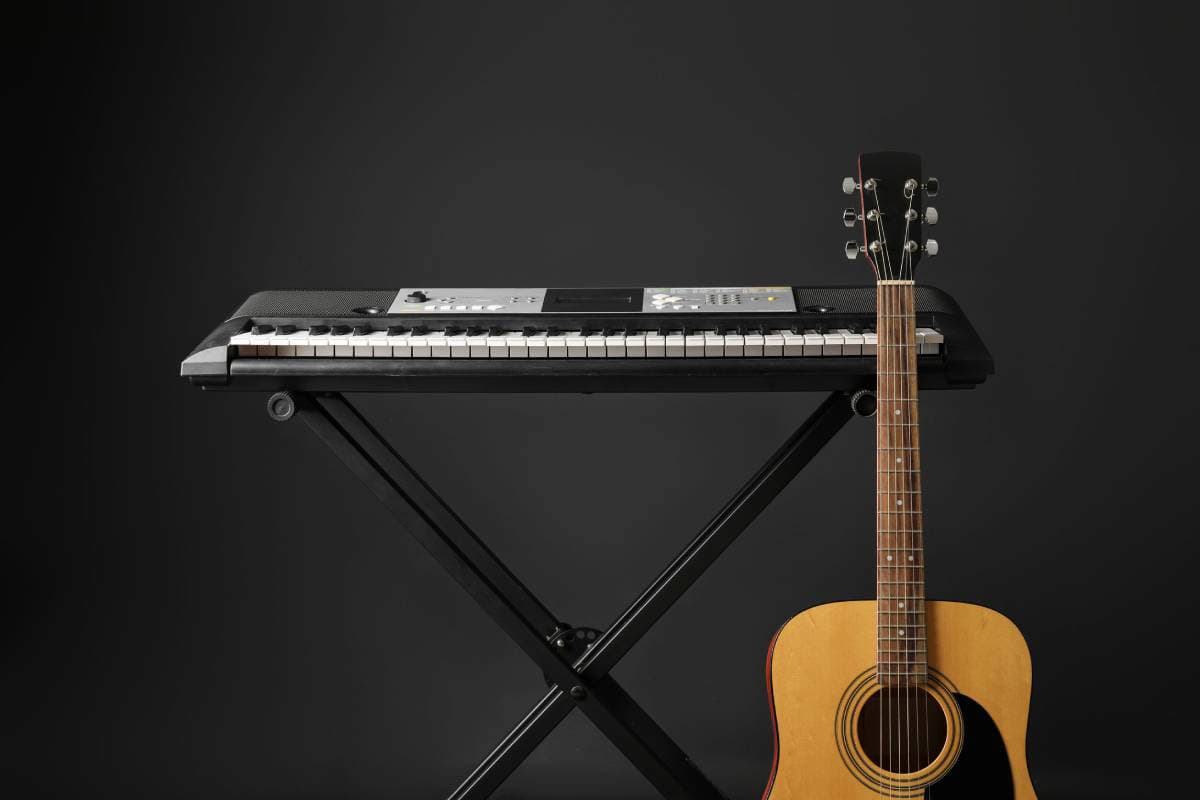Learning how to play a musical instrument can be an exciting challenge. For many, it’s not an easy endeavor, but it’s worth it to be able to create and share your art with loved ones, crowds, or just to play it for yourself. The two most popular instruments played in the United States are the piano and guitar, but how do these instruments compare in terms of difficulty?
Guitar is generally easier than piano as far as reading music, playing songs, and self-teaching go. However, navigating the layout of a guitar is harder than learning the layout of a piano. Both instruments require proficiency in challenging techniques.
In the rest of this article, I’ll discuss the factors that should be considered when determining which instrument is more challenging to play and explain my verdict for each category in detail. I’ll also discuss the pros and cons of playing each instrument to help you determine which one is better suited to you and your interests. If you’re a music lover and want to pick up an instrument but aren’t sure which one is right for you, keep reading!
👇😀👇NOTE👇😀👇
If you want to find out what my recommended guitar gear is, then here is what I recommend on Amazon:
- Fender Cutaway Acoustic-Electric Guitar Bundle (MY FAVORITE GUITAR)
- Snark SN-8 Super Tight All Instrument Tuner (Easiest Tuner I’ve Used😏)
- 6 String Acoustic Guitar Capo (Best CAPO for quick changes)
- Dunlop Max Grip 1.0mm Nylon Picks (Thick Guitar Pick So You Don’t Lose Grip!)
- Universal Guitar Stand (Cheap & Minimalist Guitar Stand I Recommend)
- Levy’s 2″ Wide Quick Adjust Guitar Strap (Best Guitar Strap For Any Level)
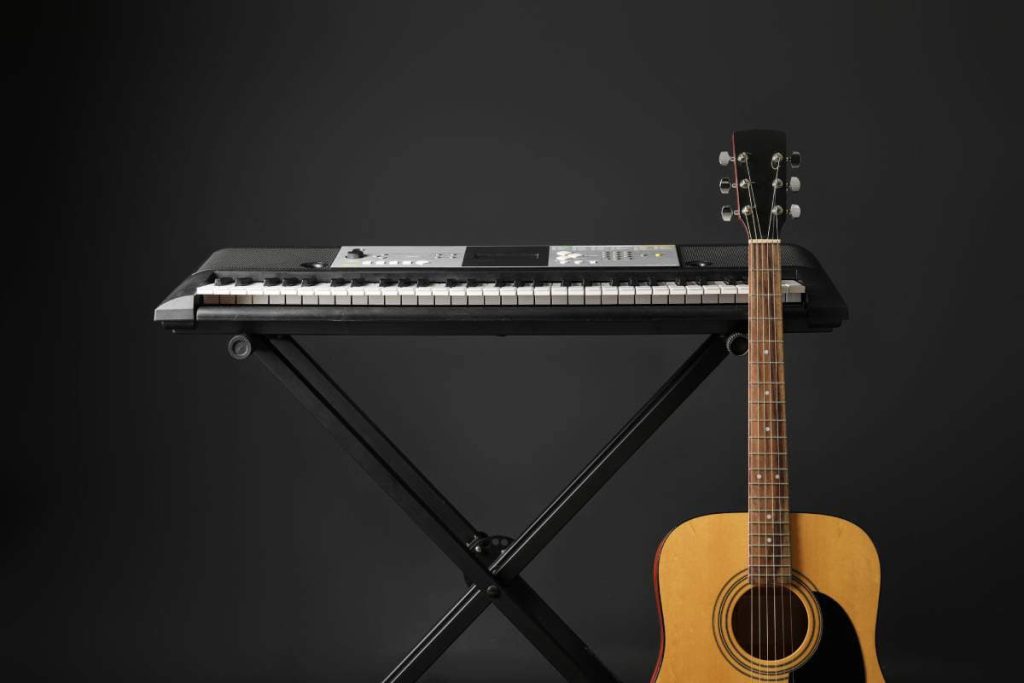
Is Guitar Harder Than Piano?
Guitar has a harder layout to navigate than the piano; however, reading music, playing songs, and self-teaching tend to be easier for guitar players than piano players. Both instruments are technically challenging.
When determining how hard the guitar is compared to the piano, the following factors must be taken into consideration:
- Layout
- Reading music
- Playing songs
- Self-teaching
- Technique
The following table summarizes each instrument’s challenges, or lack thereof, in each of these categories:
| Category | Piano | Guitar |
| Layout | Simple layoutOne repeating pattern for keysMusical alphabet repeats itself linearlyPlayer is able to see what they’re doing | More challenging layoutScales are not linearMore challenging for players to see what their fingers are doing on the guitar’s neck |
| Reading Music | Requires fluency in reading music on the Grand StaffTreble and bass clefs | Can use guitar tabs instead of standard musical notationMore visual and easier to understand than the Grand Staff |
| Playing Songs and Singing | Typically need to learn more musical theory to make chords and chord progressions sound goodMore challenging instrument to sing along with | Many songs require just a few chords and mastery of a strumming patternWith practice, the strumming pattern becomes mindless, which makes singing simultaneously easier |
| Self-Teaching | More difficult to self-teach because of the theoretical knowledge requiredDifficult to teach oneself how to read music | One can easily teach themself a few chords and a strumming pattern, and this could enable them to play several different songs |
| Technique | Easier technique in the beginner stageIn intermediate and advanced stages, both hands may be required to perform complicated fingeringLarge surface area | More challenging technique in the beginner stageOnly one hand is required to perform complicated fingering |
Let’s discuss each of these factors in greater detail.
Layout
Even though a piano has more strings than a guitar, the guitar has a more complicated layout that makes learning scales more challenging. Additionally, beginners may struggle with the physical demands of the instrument.
Pianos have a simple, uniform layout, in which each octave contains seven white notes and five black notes. Some pianos have more keys than others, but the keys are always organized in the same way: a group of two black keys, a gap, and then three black keys. This pattern repeats itself across the entire length of the keyboard. As the notes go further to the right, they get higher in pitch, and the further to the left, the lower the pitch.
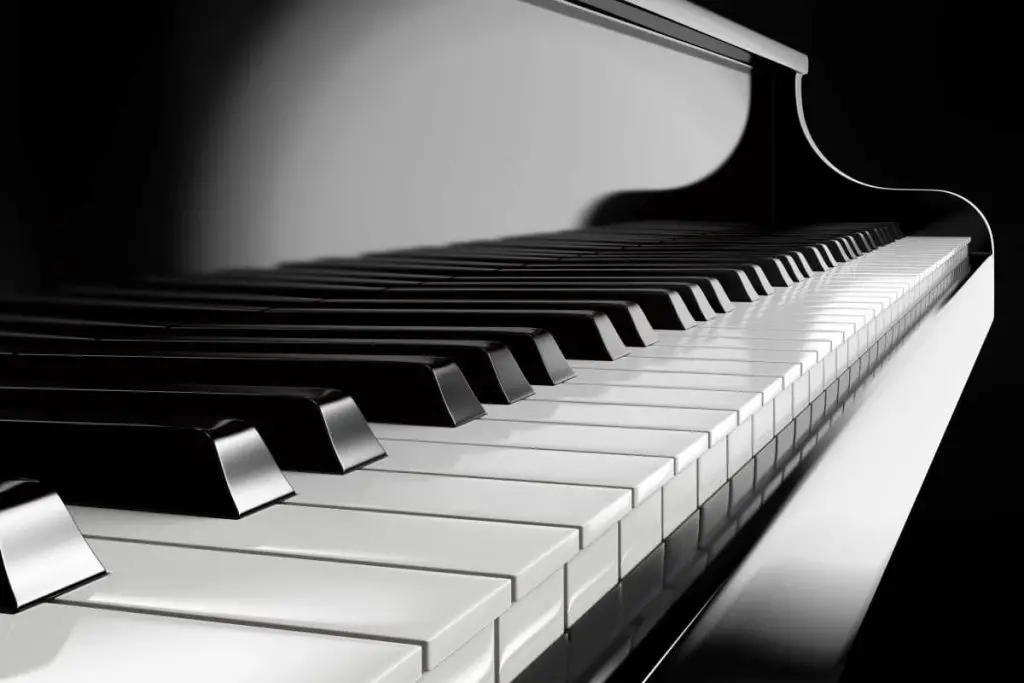
The musical alphabet, A through G, is repeated over and over again on the keyboard. This means that you can always determine which note a key represents as long as you can determine one note.
Typically, beginners focus on being able to find “Middle C,” which is the key that is directly in the middle of the grand staff. Like all C keys on a piano, Middle C is located to the left of a group of two black keys. Once one finds Middle C, they can determine which notes all other keys on the piano represent.
This linear layout makes playing scales simpler compared to scales on other instruments, such as the guitar. The notes on scales follow each other from left to right, just with different uses of the accidental keys, which are the black keys that represent a sharp or flat.
The simple layout of pianos also makes them easier to play physically. If a piano player has a suitable piano for their physical size, they shouldn’t struggle to reach notes. Furthermore, playing the piano doesn’t require much physical strength, just a bit of hand flexibility.
In contrast, the layout of a guitar is much more challenging to learn, despite a guitar only having six strings compared to a piano’s two hundred. The fretboard of a guitar is complicated to understand, although, with enough practice, patterns begin to emerge that make learning easier.
Guitars have six strings, and on each string, there is a sectioned part on the neck. This is called a fret. Plucking a particular string with a finger covering said string over a certain fret creates a unique pitch, and by combining these different arrangements, one can create music. When held horizontally, the lower strings are lower in pitch, and the top strings are higher.
Furthermore, the guitar’s physical layout presents more challenges to the player. When you’re seated at a piano, you can easily look down and see which keys you’re pressing, which can help you determine when you’ve made a mistake. However, it can be difficult, especially for beginners, to see how their fingers are positioned on the guitar’s neck. Therefore, guitar players can’t rely on visual cues as much as piano players can.
When it comes to the layout of the instruments, the guitar definitely presents the bigger challenge. Pianos may have more keys, but they are organized far more simply and uniformly, making learning the layout easier.
Reading Music
Reading music is easier when playing the guitar than the piano. Guitarists can use guitar tablatures that show correct finger placement and use numbers instead of music notation. Piano players, on the other hand, must learn the Grand Staff to read piano sheet music.

Unlike guitar players, piano players don’t have a short-hand notation they can use to get the notes for a song; they simply have to learn how to read and recognize notes on the Grand Staff. Piano players use both the bass clef and treble clef, so they essentially have to be able to read two different codes at the same time.
My favorite resource for learning how to read music is a book called How to Read Music in 30 Days: Music Theory for Beginners, which is available on Amazon. I always recommend this book because its thirty-day program makes learning how to read music attainable and fun. There are also more than 150 examples, 100 exercises, and ten listening experiences.
The following video explains how to read music on the grand staff:
Guitar players, contrastingly, have another option. Guitar tablature, or guitar tabs, show you which notes to play and how and where to play them. Therefore, it’s possible to learn how to play the guitar without ever learning how to read traditional musical notation.
Guitar tabs are a visual representation of notes. The guitar tab has six horizontal lines representing the six strings on a guitar. Each line will also have numbers representing the frets on your guitar. Notes are written in chronological order, so if all the numbers are in a line, this indicates that you’re to play a chord.
Guitar tabs are more visual than your standard musical notation, and many musicians consider them easier to learn and understand than the Grand Staff. For this reason, the guitar is not as hard as the piano when it comes to reading music.
Playing Songs and Singing
It’s easier to learn a song to sing along to on the guitar than on the piano. Many songs accompanied by a guitar use similar strumming patterns and chords, so once you have a general mastery of these, you can play a wide range of songs and genres.
One of the many reasons people might want to learn how to play an instrument is so they can play a song and sing it at the same time. While this is certainly possible on both piano and guitar, it is typically easier and quicker to learn how to play a song on guitar to sing along to than on the piano.
One reason for this is that many songs use a small selection of chords throughout, so if you learn those chords and master a simple strumming pattern, you’ll be able to play many of them quickly. You won’t sound like Jimi Hendrix, but you’ll be able to re-create many popular songs relatively quickly, which can be encouraging.
Additionally, many musicians find it easier to sing along to a guitar because practicing the strumming pattern becomes mindless. In contrast, the piano requires more concentration, which means less focus needs to be on singing and more on the instrument.
Pianists can also learn chords quickly, but usually, they master musical theory first, so their chord progressions sound smooth. There are also large gaps between some consecutive chords on a piano, which requires more focus on the hands and less on the voice.
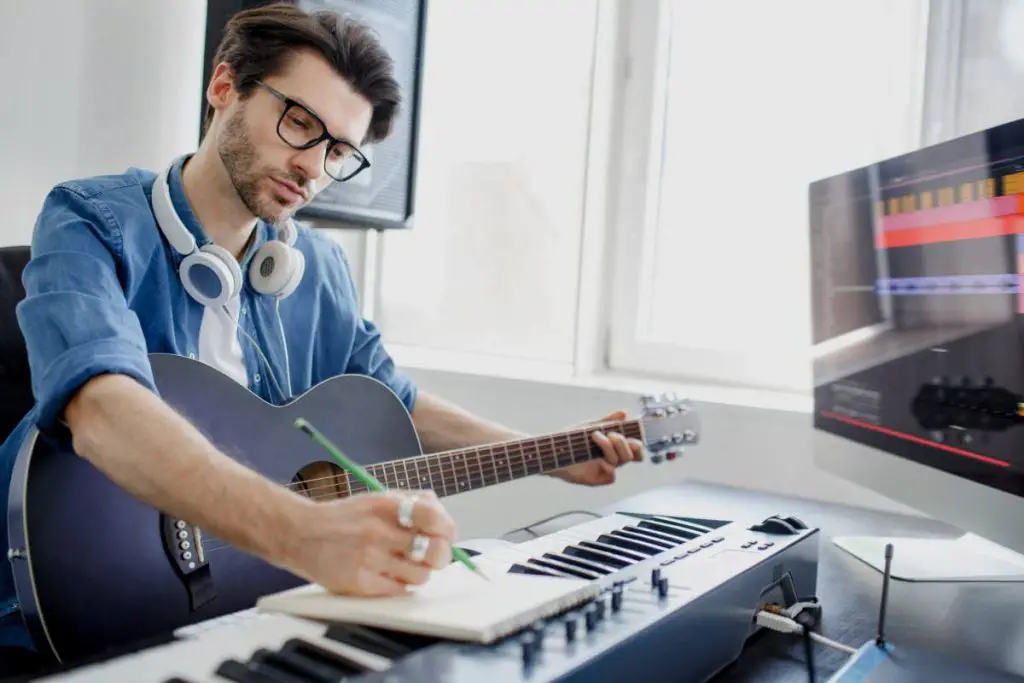
Self-Teaching
It’s easier to teach oneself how to play the guitar than it is to self-teach the piano. Playing the piano requires knowledge of how to read music, whereas most of learning how to play the guitar is strumming chords, which is easier to accomplish on one’s own.
If you’re starting at the very beginning and can’t afford or don’t want lessons for whatever reason, it is typically easier to learn how to play the guitar than it is to learn the piano solo.
One of the main reasons for this is that playing piano requires you to know how to read music on a Grand Staff, and this can be challenging to learn without a teacher. Furthermore, the piano requires more knowledge of musical theory than the guitar does, and these ideas can be difficult to grasp without the guidance of a teacher.
On the other hand, someone could pick up a guitar, learn a few chords by looking at guitar tabs, pick a strumming pattern, and be playing recognizable songs in a few days. While it is helpful to know musical theory before playing the guitar, it isn’t necessary in the same way as it is for pianists. Because most guitar music uses the same popular chords, it is easier to learn how to play by ear.
This resource, Alfred’s Basic Guitar Chord Chart: A Chart of All the Basic Chords in Every Key from Amazon, can help you teach yourself all the essential guitar chords. It’s a comprehensive poster that you can refer to repeatedly to teach yourself the most important chords you’ll need to know to start playing your favorite songs.
Technique
For beginners, the technique required to play the guitar is more challenging. However, after the beginner stage, piano technique is more challenging.
The piano is often the instrument that people choose to learn first or the instrument that they encourage their children to play. This is largely because, in the beginning, piano technique is relatively easy.
At first, the hands are usually in similar positions on the keyboard, and only one hand is playing at a time. Furthermore, if you play a note on the piano, it will sound correct (as long as the piano is tuned), no matter how hard or awkwardly you strike the key. For this reason, it is easier to make the piano sound good in the beginning than it is to make a guitar sound good
The technique required to play guitar can be quite the challenge for beginners. One has to press the strings in the correct position and with enough force, or else the note won’t sound right, or there will be an annoying buzzing sound. Additionally, the coordination required to pluck with the right hand and place fingers in a particular way with your left can be difficult to master at first.
As if that weren’t enough, when beginner guitar players first start out, their fingers are not accustomed to the rough strings rubbing against their skin. Calluses develop with enough practice, which helps alleviate the pain involved in this process, but it can take a while before the calluses are helpful and not hurtful.
Therefore, playing the piano is easier than playing the guitar in the beginning stage. However, this changes once one progresses in their skill.
Playing the piano becomes more difficult because the songs require more from the pianist. They must read the notes on the Grand Staff, understand the bass and treble clefs simultaneously, identify which notes to play, adjust how much force they apply when pressing the key according to dynamic cues, employ the pedal appropriately, and navigate five feet of space. It’s a lot to do!
Even in the most complicated guitar songs, the hands are co-dependent in sound production, so they’re working together, and only the left hand has to perform challenging positions. In contrast, the right hand just has to strum. On the piano, both hands can be performing complicated maneuvers at the same time and far apart from each other.
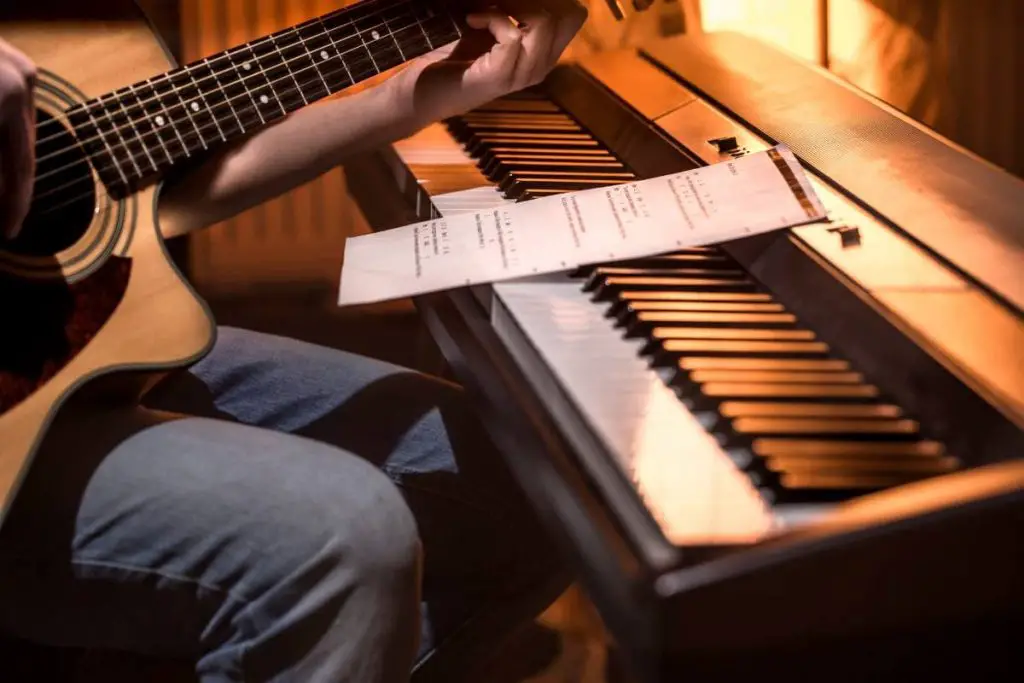
Guitar vs. Piano: Pros and Cons
Both the guitar and the piano are beautiful instruments that would be great to learn how to play. There’s a reason they’re the two most popular instruments played in the United States! However, if you’re struggling to determine which one you should start learning first, the following table outlines the pros and cons of each for you to consider:
| Instrument | Pros | Cons |
| Piano | Improves memoryImproves brain speed helps with concentration and focus improves reading comprehensionEncourages creativity strengthens hand musclesStrengthens hand-eye coordination you can play almost any song on piano you’ll learn how to read music | Pianos can be extremely expensive pianos are heavy, bulky, and difficult to movePiano tuning is expensive more difficult to self-teach, so lessons are needed not mobile |
| Guitar | Mobile more affordable options are available encourages creativity Improves memory Reduces stress easier to sing along with Great for songwriting Easier to master | Requires regular tuning Some guitars are expensive depending on the model can be painful at first due to the strings rubbing against the skin |
Ultimately, the best instrument for you is not what’s easier but what you’re most excited about.
Conclusion
Learning an instrument is never easy, and both the piano and the guitar present challenges to any player. The layout and physical challenges of playing the guitar may be greater than those of a piano, but reading music, playing songs, and self-teaching is easier for guitar players than pianists. However, every instrument becomes easier to play with enough practice and passion.
👇😀👇NOTE👇😀👇
If you want to find out what my recommended guitar gear is, then here is what I recommend on Amazon:
- Fender Cutaway Acoustic-Electric Guitar Bundle (MY FAVORITE GUITAR)
- Snark SN-8 Super Tight All Instrument Tuner (Easiest Tuner I’ve Used😏)
- 6 String Acoustic Guitar Capo (Best CAPO for quick changes)
- Dunlop Max Grip 1.0mm Nylon Picks (Thick Guitar Pick So You Don’t Lose Grip!)
- Universal Guitar Stand (Cheap & Minimalist Guitar Stand I Recommend)
- Levy’s 2″ Wide Quick Adjust Guitar Strap (Best Guitar Strap For Any Level)

